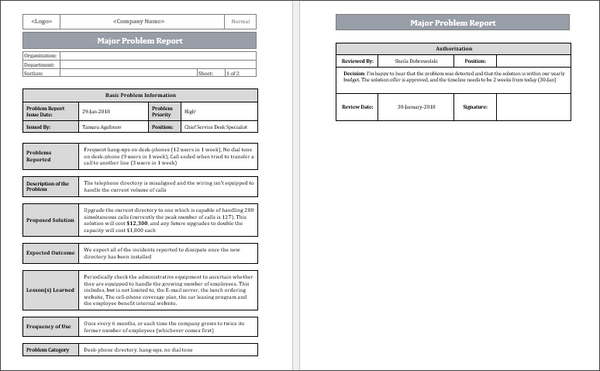Major Problem Report Template
Many organizations struggle to differentiate between problems and incidents, and the ITSM methodology aims at clarifying the difference between the two incidents vs Problem: A problem refers to the unknown cause of one or more incidents. To use a simple analogy: If a problem is like a disease, then the incidents are the symptoms.

ITSM Major Problem Report Template
8 Steps to Resolve an ITSM Problem
Whenever the service desk encounters a major problem within its systems, there are eight steps that it needs to perform in order to resolve the problem –
Detection
The first step is to identify the root cause of the problem and not just the lone incident which is only a symptom of the problem. This requires identifying incidents throughout the organization, either proactively or by receiving multiple service requests.
Recording
Since a service desk usually has more than one employee, it is important to share all the incidents. This will help in identifying the root cause of the problem and will serve as a log for lessons learned and future improvements.
Categorizing
Since each user fills in a service request a bit differently, it is important to categorize them as they come in. This will help in modeling the incidents, which will allow the service desk to collate as many incidents into one major problem and solve it. It is possible to have more than one category. For example, the Main category is “Communication”, whilst the second one is “Desk Phone”.
Prioritizing
Once all the requests are recorded and categorized, it is important to prioritize them in order of urgency and importance. Ideally, the more important ones will be solved first, although most organizations solve the urgent ones first.
Diagnosing
Now comes the hardest part, figuring out what the problem is and deciding on how to solve it. This step of course requires the most amount of time, and it shouldn’t be rushed. Once the problem has been diagnosed and the root problem is detected, the service desk needs to suggest the best solution for rooting out the problem.
Workaround
If the suggestion in the previous step was approved, now the team needs to implement the solution across the organization. This step requires the whole team to understand the problem, the solution, and to implement it in the same manner.
Documentation
After the problem has been solved, documenting the entire process (from stet #1 to #6) will assist in resolving future issues. This should be done in a set template, which will help in familiarizing the team with the process.
Lessons Learned
The final step is more often than not skipped since most of the service desk employees don’t see an immediate benefit in doing so. This task usually falls on the team leader of the service desk and is very important for the organization to grow and learn from its mistakes.
How it fits into the ITSM methodology
This process is crucial for the long-term success of the organization and is the core foundation of a robust service desk entity. The problem resolving collates many different incident reports, and is internal as well as external facing.







